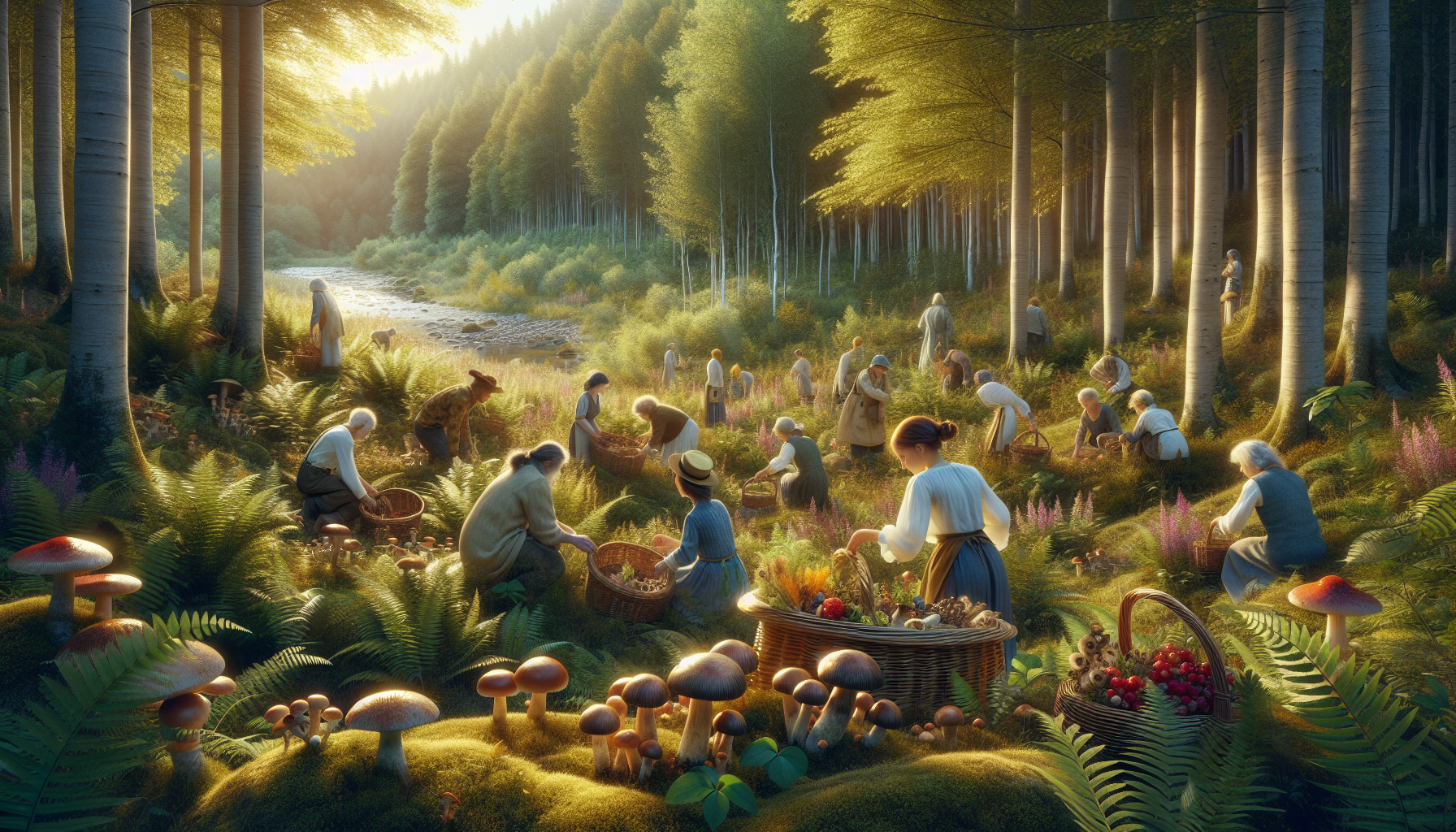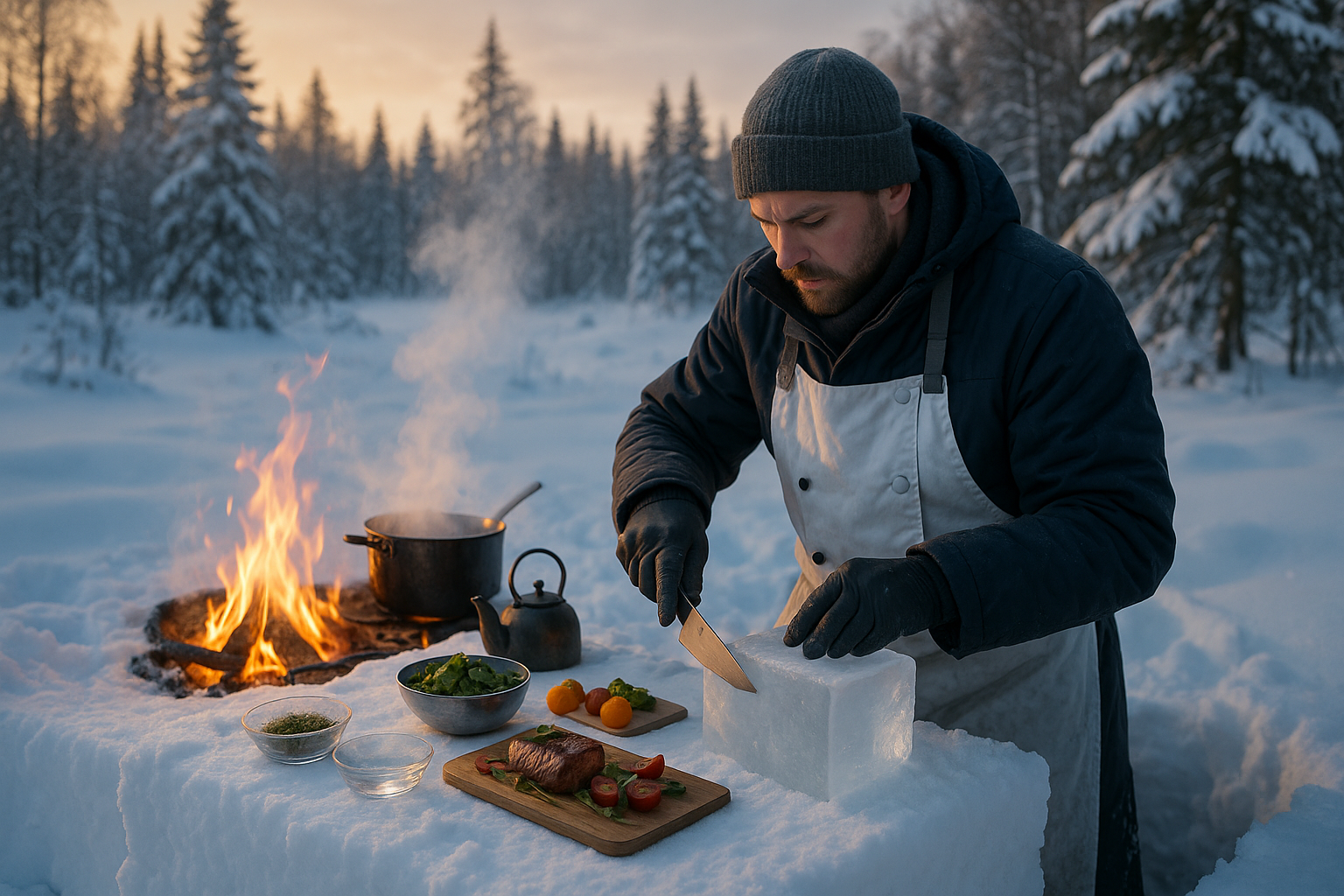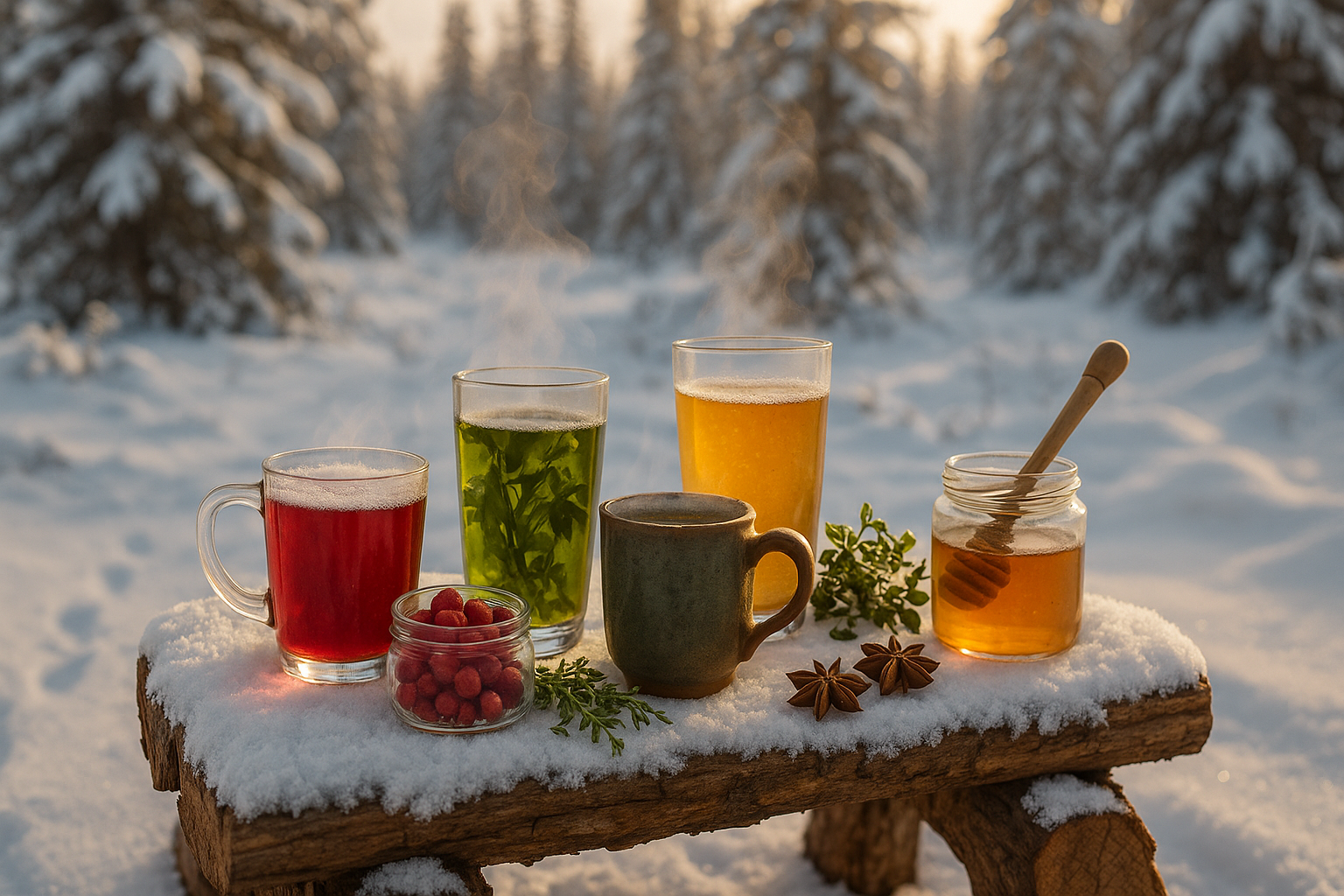In an age where convenience often trumps tradition and the rhythm of nature seems a distant echo, a remarkable practice is experiencing a renaissance: seasonal foraging. As we rush through our modern lives, rarely pausing to contemplate the roots beneath our feet or the bounty hanging just above our heads, foraging offers a unique opportunity to reconnect with the world around us. This ancient practice, once a necessity for survival, now serves as a bridge to mindfulness, sustainability, and the simple joy of discovery. With each season unveiling its own unique treasures, the magic of foraging invites us to embrace the earth’s cycles and savor the gifts it generously provides. 🌿
Imagine wandering through a sun-dappled forest, the ground carpeted with vibrant foliage, as you hunt for nature’s hidden gems. The thrill of finding a cluster of chanterelles peeking through the underbrush or the delight in spotting a bush laden with plump, ripe berries is an experience that engages all the senses. Seasonal foraging is not just about gathering food; it’s about the journey, the stories, and the traditions that come alive with each expedition. This practice connects us to our ancestors, who relied on their knowledge of the land to provide sustenance and healing, and it empowers us to become stewards of our environment, fostering a deeper appreciation for the earth’s resources.
As we delve into the world of seasonal foraging, we will explore the diverse array of plants, mushrooms, and wild edibles that define each season. From the tender greens of spring to the robust fruits of autumn, every period of the year presents its own palette of flavors and textures. This guide will equip you with the knowledge to safely identify and responsibly harvest nature’s offerings, ensuring that both novice and experienced foragers can partake in this rewarding pursuit. We will also delve into the historical and cultural significance of foraging, examining how different communities have celebrated and utilized these practices throughout time.
In addition to the practical aspects, we will uncover the rituals and traditions that have developed around foraging. From the ceremonial gathering of herbs for medicinal teas to the communal berry-picking festivals that mark the height of summer, these customs add depth and meaning to the act of foraging. They remind us that this is not merely a solitary activity but a shared experience, one that can strengthen bonds with family, friends, and neighbors. By embracing these traditions, we honor the past while cultivating a more sustainable and mindful future.
So, whether you’re a seasoned forager or a curious newcomer eager to dip your toes into the world of wild edibles, this journey will reveal the countless ways in which foraging can enrich your life. As we traverse through each season, you’ll gain insights into the environmental and health benefits of foraging, learn about ethical practices, and discover delicious ways to incorporate wild ingredients into your culinary repertoire. Prepare to unlock the magic of seasonal foraging and embrace the bounty that nature has to offer, one adventure at a time. 🌲
The Art of Seasonal Foraging: A Timeless Tradition
Seasonal foraging is an age-old practice that connects us deeply with the natural world, allowing us to tap into the bounty that each season offers. This practice not only provides us with fresh and nutritious ingredients but also instills a sense of rhythm and connection to the Earth’s cycles. The tradition of foraging varies greatly depending on geographical locations, climates, and cultural backgrounds, making it a rich subject to explore.
One of the primary benefits of foraging is the opportunity to harvest foods at their peak of freshness. Unlike store-bought produce that may have been harvested weeks before, foraged foods are often consumed shortly after picking, preserving their flavor and nutrients. Additionally, foraging can introduce you to a variety of wild edibles that are not commonly found in supermarkets, such as ramps, morels, and wild berries.
Moreover, the act of foraging itself is a rewarding experience. It encourages mindfulness and appreciation of nature as you learn to identify plants, understand their ecosystems, and respect their natural habitats. Foraging is not just about collecting food; it’s about building a relationship with nature and understanding the roles that different plants play in their environments.
Seasonal Rituals: Spring
Spring is a season of renewal and growth, offering a vibrant selection of young greens, wild herbs, and mushrooms. As the snow melts and the earth awakens, foragers can begin to harvest some of the most delicate and flavorful wild edibles. Common spring foraged foods include wild garlic, stinging nettles, and fiddlehead ferns.
The process of foraging in spring is often accompanied by rituals and traditions passed down through generations. Many cultures have celebrations that mark the arrival of spring, and foraging can be a central component of these festivities. Gathering together to forage and prepare meals fosters community bonds and a shared appreciation for the season’s gifts.
Incorporating spring foraged foods into your diet can be both exciting and beneficial. Many of these foods are rich in vitamins and minerals, providing a nutritional boost after the long winter months. To explore more about spring foraging techniques and recipes, check out this informative video on YouTube.
Summer’s Abundance: Fruits and Flowers
Summer is a time of abundance, with a plethora of fruits, flowers, and berries ripe for the picking. The longer days and warmer weather make it an ideal season for foraging expeditions. This is the time to harvest sweet berries, juicy fruits, and vibrant flowers that can be used in a variety of culinary and medicinal applications.
Foraging in the summer often involves long, leisurely days spent in fields, forests, and along riverbanks. It’s a season that encourages exploration and discovery as new plants come into bloom and offer their bounty. Popular summer foraged items include elderflowers, blackberries, and wild strawberries.
To maximize your summer foraging experience, it’s important to be prepared and knowledgeable about what you’re looking for. Equip yourself with a good field guide and familiarize yourself with the local flora. Engage with local foraging groups and communities to learn from experienced foragers who can offer valuable insights and tips.
The Nutritional Value of Foraged Foods
One of the most compelling reasons to embrace foraging is the exceptional nutritional value of wild foods. Many foraged plants, berries, and mushrooms are nutrient-dense, offering vitamins, minerals, and antioxidants that are crucial for maintaining health. These nutrients can be more potent in wild plants compared to their cultivated counterparts.
| Foraged Food | Nutritional Benefit |
|---|---|
| Nettle | High in iron, vitamin C, and antioxidants. |
| Elderberry | Rich in vitamin C, dietary fiber, and antioxidants. |
| Morel Mushroom | Contains copper, phosphorus, and high levels of vitamin D. |
Foraged foods not only provide nutritional benefits but also offer a diversity of flavors and textures that can transform meals. The experience of foraging and consuming these foods can enhance your appreciation for the complexities of taste and the artistry of culinary traditions.
If you’re interested in diving deeper into the nutritional aspects of foraged foods, consider watching this educational video on the subject, which explores the health benefits and culinary uses of various wild edibles.
Environmental Impact and Sustainability
Foraging, when practiced responsibly, can be a sustainable way to procure food that minimizes the environmental impact compared to commercial agriculture. Wild foods require no planting, watering, or fertilization, and foraging can help promote biodiversity by encouraging the growth of native plant species.
However, responsible foraging is crucial to ensure that natural habitats are not overharvested. Foragers must adhere to principles of sustainability, such as taking only what they need, leaving plenty for wildlife, and avoiding sensitive or endangered species. This approach ensures that ecosystems remain balanced and that foraging can continue for generations to come.
- Learn and identify local plant species.
- Harvest responsibly, leaving some plants untouched.
- Respect private property and protected lands.
As you consider the environmental aspects of foraging, watch this insightful video that highlights sustainable foraging practices and the importance of ecological balance.
Preserving the Harvest: Storage and Preservation Techniques
Once you’ve gathered your foraged treasures, preserving them for future use is a valuable skill that ensures you can enjoy nature’s bounty long after the season has passed. There are several methods for preserving wild foods, each with its unique advantages and applications.
Drying is one of the oldest and most effective methods of preservation, especially for herbs, mushrooms, and fruits. Dehydrating removes moisture, preventing spoilage and retaining flavors and nutrients. Dried foods can be stored in airtight containers and used throughout the year in soups, stews, and teas.
| Preservation Method | Suitable For | Benefits |
|---|---|---|
| Drying | Herbs, mushrooms, fruits | Long shelf life, retains nutrients |
| Fermentation | Garlic, berries, vegetables | Probiotic benefits, enhances flavor |
| Freezing | Fruits, berries, greens | Retains freshness and texture |
Freezing is a modern preservation technique that maintains the freshness and texture of many foraged items, such as berries and leafy greens. Proper preparation before freezing, such as blanching, can help preserve the color and flavor of your harvest.
For a deeper understanding of these preservation techniques, watch this comprehensive video guide on how to store and preserve wild foods effectively.
Embracing the rituals and traditions of seasonal foraging allows us to reconnect with nature and appreciate the diverse offerings of each season. As you embark on your foraging journey, remember to respect the environment, savor the flavors, and share your experiences with others. Happy foraging! 🍄🌿

Conclusion
Unlocking the magic of seasonal foraging is more than just a journey into the wilderness; it is an embrace of nature’s bounty and a return to our roots. Throughout this article, we have delved into the myriad ways that foraging can enrich our lives, both physically and spiritually. By understanding the cycles of nature, we reconnect with a part of ourselves that has been largely forgotten in our modern, fast-paced world.
One of the key points we explored is the deep connection between foraging and sustainability. When we engage in responsible foraging practices, we not only nourish our bodies with fresh, organic produce but also contribute to the preservation of ecosystems. The act of foraging encourages us to be mindful stewards of the land, ensuring that these natural resources remain available for future generations.
Furthermore, we discussed the importance of traditional knowledge and rituals associated with foraging. These practices, passed down through generations, carry with them a wealth of cultural heritage and wisdom. They offer a unique perspective on how our ancestors lived in harmony with the earth, utilizing the seasonal gifts provided by nature. By reviving these traditions, we can gain a greater appreciation for the world around us and foster a sense of community as we share these experiences with others.
In addition to cultural and environmental benefits, foraging also provides significant health advantages. The wild foods we gather are often richer in nutrients than their cultivated counterparts, offering a diverse array of vitamins, minerals, and antioxidants. Moreover, the act of foraging itself—walking through forests, fields, and along riverbanks—promotes physical fitness and mental well-being. The peacefulness of nature provides a perfect backdrop for mindfulness and meditation, allowing us to escape the stresses of daily life and reconnect with ourselves.
Embracing the rituals of seasonal foraging also opens up a world of culinary possibilities. The flavors of wild foods are unique and often more vibrant than those found in stores, inspiring creativity in the kitchen. By incorporating these ingredients into our meals, we not only enhance our diets but also cultivate a deeper connection to the land and the seasons.
As we conclude this exploration of seasonal foraging, it’s crucial to recognize the importance of sharing this knowledge and experience with others. By doing so, we can inspire a new generation to appreciate the natural world and engage in sustainable practices. Whether you are a seasoned forager or a curious beginner, there is always something new to learn and discover in the world of wild foods.
We encourage you to take what you have learned here and apply it in your own life. Venture into the wild spaces near you, respect the land and its offerings, and embrace the adventure of foraging. Share your experiences and insights with others, fostering a community that values and protects the natural world. By doing so, you not only enrich your own life but also contribute to a greater collective understanding and appreciation of our environment.
In a world where technology often dominates our attention, taking the time to engage with nature through foraging can be a transformative experience. It reminds us of the beauty and abundance that exists outside our doors, waiting to be discovered and cherished. As we unlock the magic of seasonal foraging, we find ourselves more attuned to the rhythms of the earth, leading to a more balanced and fulfilling life.
Thank you for joining us on this journey into the heart of nature’s bounty. We hope this article has inspired you to explore the world of foraging and to share your newfound passion with others. Let’s create a community of nature enthusiasts who are committed to preserving the environment and celebrating the rich traditions of foraging. Together, we can make a difference, one wild harvest at a time. 🌿
References:
–
–
–





